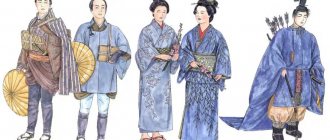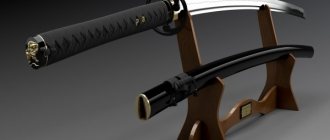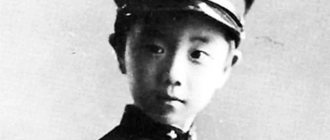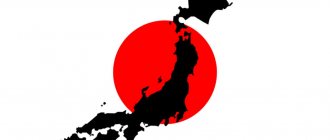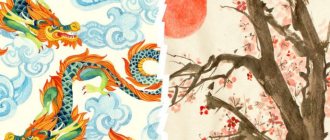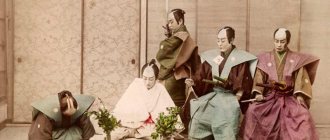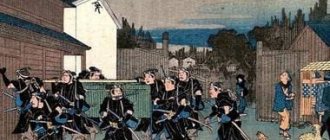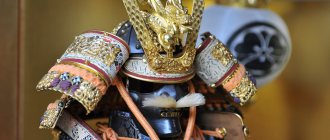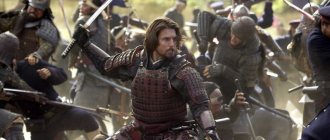Japanese culture is strikingly different from the European ones we are used to. The differences concern important issues such as morality, dignity and death. The differences are especially clear in attitudes towards suicide. Europeans have long considered suicide a sin and an unworthy act, while the Japanese turned it into a ritual, possible and sometimes necessary for an honest person.
The concept of honor among the Japanese aristocracy is based on two important doctrines: to die at any time for your master and to save your face and the good name of your family before others. If the shame of a warrior became known, he was given the opportunity to show his strength of spirit and purity of thoughts through ritual suicide. In ancient Japan, warriors resorted to self-immolation or hanging. It was only in 1156 that the ritual of “ripping open the belly” began to be popularized in Japan. The first to commit seppuku was the daimyo Minamoto no-Tamemoto in order to avoid capture as a result of a brutal clan war.
The difference between harakiri and seppuku
The difference between hara-kiri and seppuku is manifested in their writing and reading. The words themselves consist of two identical hieroglyphs: “rip open” and “belly.” Only the hara-kiri (腹切り) entry puts “belly” first and uses the “kun” Japanese reading, while the seppuku (切腹) entry begins with the word “to cut” and is read with the “onny” Sino-Japanese reading.
It is believed that hara-kiri is found in colloquial speech, while seppuku is more often seen in official documents. In fact, the Japanese themselves use both terms as synonyms for the same ritual action.
Committing ritual suicide
Among the samurai, it was customary to carry two swords: with a long sword, the “katana,” to fight, and with a short sword, “wakizashi,” to behead victims. It is with a short blade that harakiri is committed, although in the drawings you can see samurai ripping open their stomachs with a long sword. Such images date back to the early period, when the rules for committing seppuku were not spelled out in detail. There is an option to use a blade without a handle. In this case, the blade was wrapped in several layers of paper for convenience.
Traditionally, the place where hara-kiri was performed was covered with a white cloth. The future suicide himself wore a white kimono. This color expresses mourning and sorrow among the Japanese. If seppuku was committed in nature, then a small area of land was covered with sand and leveled. Fencing pegs were installed along the edge.
Two people took part in the ritual action: a samurai who decided to commit hara-kiri, and a kaisaku who beheaded the victim. The latter was chosen from among close friends. Only a person who has sincere feelings for a suicide is able to cut off the head of a dying person with one swing of a long sword and save the dying person from suffering. A special art was to cut the neck so that a thin strip of skin remained in front. In this case, the head of the person who committed seppuku was bowed on his chest, and the flowing blood did not stain the spectators.
The last minutes of the samurai
Committing hara-kiri required special courage from a person. Spectators often watched the ritual action. The suicide would go to the center of the site and sit down with his knees folded and his upper body exposed. Sometimes the kimono was left on the shoulders, and the sleeves were tucked under the knees. Thus, the clothing prevented the dying person's body from leaning back.
Usually a stack of rice paper, a feather and an inkwell with ink were placed in front of the samurai. On the other side they placed a bowl of sake. Traditionally, before seppuku, an alcoholic drink was drunk, parting words were written, and only then a ritual knife was taken into hand. The abdominal incision was made in horizontal and vertical planes, forming a right angle. The most difficult technique was considered jumonji giri, when two movements depicted a cross on the stomach or the Japanese number 10 - “ju”. If the pain allowed, then the samurai with the last movement cut his carotid artery. It was important for the dying man not to show his suffering, and until the last he tried to maintain a straight body position. When the body began to lean forward, the kaisaku completed the ritual with one stroke.
Commemoration of the person who laid hands on himself was carried out immediately after the ritual. The owner escorted the audience to separate chambers and treated them to tea and sweets.
How was the rite of harakiri (seppuku) performed?
In order for seppuku to be carried out correctly, the strictest adherence to a set of rules was required, which clearly regulated every step of the ritual. First, it was necessary to find an assistant (called “kaishaku” or “kaishakunin”), who was appointed as an official (if the order to do seppuku came from the shogun’s government) or a close friend or relative of the samurai who wielded a sword to the proper degree (in the case when the decision to commit ritual suicide was voluntary).
The best place to perform the seppuku ritual was a garden or a Buddhist temple (Shinto temples are not suitable for these purposes: they cannot be desecrated by murder). The samurai who was to commit hara-kiri dressed in white clothes, symbolizing the purity of intentions. He had to sit in the seiza position (the traditional Japanese way of sitting on one's knees). A servant brought a wooden table on which sat a cup of sake and sheets of traditional Japanese washi paper made from the bark of the mulberry tree. In addition, there were writing utensils and a kozuka knife on the table. Also, a tanto could be used as a knife - a dagger without a hilt, wrapped in several sheets of paper so that it could be held by the blade.
Sometimes samurai used a bamboo sword (!) rather than a steel one, which made cutting the stomach extremely difficult and extremely painful. The samurai rather did not cut, but tore it apart, which required special endurance and willpower. Such a death was considered especially honorable, glorifying the samurai, exalting his name and the glory of his family. In some cases, for example, when a person was too young or too dangerous for others, a fan was used instead of a knife. The cup was filled with sake by one of the assistants with his left hand, which under other circumstances would have been considered unforgivably rude. The person committing hara-kiri drank sake in two doses, taking two sips each time. If you drink sake in one go, it could be considered a sign of greed, and if you drink sake in three or more, it could be considered a sign of indecisiveness. In total, four sips were taken (the word “four” in Japanese is similar to the word “death”, both words sound like shi). Then it was necessary to write a farewell verse in the waka genre (the first and fourth lines have five syllables each, the second, third and fifth lines have seven syllables each, for a total of five lines). The waka had to be graceful, natural, and in no case should it mention the fact of impending death.
Tanto knife
After this, the person committing hara-kiri took off his outer clothing (kamishimo) and tucked his sleeves under his knees, while trying to prevent the clothing from falling sharply on one side. He would then take the kozuka knife in one hand while lifting the sanbo table with the other and placing it under the buttocks. At the same time, the body leaned a little forward, taking the correct position. If the person committing harakiri was replaced with a fan, the kaishaku would inflict kirioroshi - a vertical blow with the sword from top to bottom, as soon as the person touched his stomach with the fan. If harakiri was performed with a knife, then the kaishaku would wait until the person had plunged the blade deep enough into the left side of the abdomen and then draw it to the right with a sharp upward cut at the end. A samurai who found the strength could then plunge the blade into the groin and cut upward towards the chest, finishing with a horizontal cut under the ribs. Thus, the introduction of an assistant into the seppuku ritual also had the purpose of providing insurance in case of unforeseen circumstances. It happened that, due to terrible pain, samurai began to lose consciousness and could lose control over their actions and die “ugly”, falling backward and thereby disgracing their name. Kaishaku had to catch the moment of loss of control and immediately finish off the mortally wounded samurai.
The institution of hara-kiri was a method of achieving complete inner freedom, a precondition for going beyond human capabilities, achieving superhuman consciousness and will, unclouded by the animal instinct of life.” © A. R. Basov “Ascent”
Jigai and the women of the samurai class
In Japan, the wife and daughters of a samurai were required to learn weapons skills. Since only a man can be a samurai, a woman warrior was called onna-bugeisha. Unlike the buke-no-onna (a woman from the bushi class), who looked after children and could protect her home if necessary, a female warrior could participate in clan wars on equal rights. Absolute loyalty to the boss was instilled in them.
Upon reaching adulthood (12 years old), the onna-bugeisha received a short kaiken dagger. She wore it in the folds of her clothes or her sleeve. It was also used by a female warrior to commit ritual suicide. In general terms, jigai and hara-kiri are similar. Only the incision was made not along the abdomen, but through the larynx. Before the ritual itself, the ladies tied their ankles so that after death they would not appear before the audience in an uncomfortable position.
Rite of seppuku (harakiri)
Seppuku and hara-kiri are written with the same two characters. The difference is that seppuku is written as 切腹 (first comes the hieroglyph “cut” and then “stomach”, when reading “on”, Japanese-Chinese readings are used), and hara-kiri, on the contrary, is written as 腹切り (the first hieroglyph is “stomach”, “on” is used). kunnye", purely Japanese readings). In Japan, the word "harakiri" is a colloquial form and carries some everyday and derogatory connotations.
The essence of the ritual
The code of samurai honor (Bushi-do) is formulated in “Elementary Fundamentals of the Martial Arts” by Daidoji Yuzan. In general, the Bushi-do code comes down to five key principles that repeat and explain the main dogmas of Confucian morality: loyalty, politeness, courage, truthfulness and simplicity.
Inextricably linked and closely related to Bushido as part of morality is the history of the hara-kiri ritual, which arose among the warrior class during the formation and development of feudalism in Japan. Samurai or other representatives of the upper strata of Japanese society committed suicide (by the harakiri method) in the event of an insult to their honor, committing an unworthy act (disgracing the name of a warrior in accordance with Bushido norms), in the event of the death of their overlord, or (later, during the Edo period , when the ritual was finally formed) - by a court verdict as punishment for a crime committed.
Harakiri was the privilege of the samurai, who were proud of the fact that they could freely manage their lives, emphasizing fortitude, self-control, and contempt for death by performing the ritual. Cutting the abdomen required great courage and endurance from the warrior, since the abdominal cavity is one of the most sensitive places in the human body, the center of many nerve endings. That is why the samurai, who considered themselves the most courageous, cold-blooded and strong-willed people in Japan, preferred this painful form of death.
Literally translated, hara-kiri means “to cut the stomach” (from “hara” - stomach and “kiru” - to cut). However, the word “harakiri” also has a hidden meaning. If we consider the compound binomial “harakiri” - the concept “hara”, we can see that in Japanese it corresponds to the words “belly”, “soul”, “intentions”, “secret thoughts” with the same hieroglyph spelling.
According to the philosophy of Buddhism, in particular the teachings of the Zen sect, it is not the heart, but the abdominal cavity that is considered the main, central point of a person’s life and thus the seat of life. In accordance with this, the Japanese put forward the thesis that the vital forces located in the stomach and occupying a kind of middle position in relation to the whole body, supposedly contribute to a more balanced and harmonious development of an Asian than a European, whose main vital center is the heart.
Despite the fact that in some works of European authors the idea was given of identifying the Japanese understanding of the category “soul” with similar concepts among the ancient Greeks (who called the seat of the soul - “psyche” - the abdominal barrier) and the ancient Jews (the ancient Hebrew prophets spoke about the seat of the soul in intestines), "hara" in the Japanese sense is not the equivalent of soul in the European sense. Here we can talk more about feelings and emotions. And it is no coincidence that in this regard, in the Japanese language there are many expressions and sayings related to “hara”. For example, a person encouraging another to be frank in a conversation uses the expression "hara o watte hanashimasho", which means "let's talk by sharing hara", or in other words, "let's talk by opening our bellies." Also typical are sayings such as “haradatsu” (to rise to the stomach, to get angry); “haragitanai” (dirty belly, mean person, low aspirations), etc.
The Japanese also assign an important place to the “art of hara” (belly) - “haragei”, called by J. A. Coddrey “the highest form of internal communication.” This “art” refers to the process of communication between people at a distance as a result of intuitive communication and understanding each other through hints.
Thus, the Japanese consider the stomach as an internal source of emotional existence, and opening it through hara-kiri means, as it were, the discovery of one’s innermost and true intentions and serves as proof of the purity of thoughts and aspirations. In other words, according to the concepts of the samurai, “seppuku is the ultimate justification of oneself before heaven and people” and it is more symbolic of a spiritual nature than simple suicide.
Origin of the ritual
Speaking about hara-kiri as a phenomenon that developed and came to its logical conclusion on Japanese soil, one cannot fail to take into account that some other peoples of East Asia and Siberia previously encountered ritual actions that were similar and somewhat vaguely reminiscent in essence of Japanese seppuku. Stagewise, they can be attributed to an earlier time than hara-kiri itself. This suggests that the ritual of cutting the belly in the early period of the history of the peoples of the Far East was more widespread and was borrowed by the ancient Japanese, who had ethnocultural contacts with representatives of these peoples.
First of all, you should pay attention to the ritual of opening the abdomen among the Ainu. M. M. Dobrotvorsky described one of the methods of suicide of the aborigines of the Japanese islands, which consisted of cutting into the abdominal cavity (pere) and was closely reminiscent of Japanese hara-kiri. Harakiri, like pere, often had the appearance of a passive protest and was not committed out of despair; it had rather a connotation of sacrifice. Dobrotvorsky wrote down the Ainu word “ekoritokhpa”, which means “to sacrifice inau”, or literally “to cut up the stomach”. This suggests that it was originally an act of sacrifice, either voluntary, as a purifying sacrifice, or violent.
The victim's stomach could also be opened to obtain blood, which was sometimes considered as a cleansing agent. The Evenks, in particular, considered the blood of sacrificial animals to be a source of special power that could drive out all evil. This, obviously, can explain the presence of ocher in ancient burials in Siberia and Japan, which serves as a substitute for blood.
It can be assumed that ideas and rituals associated with the human abdominal cavity were characteristic of many peoples of Asia and were generally similar. Perhaps these ideas belong to an ancient layer in the worldview of the continent’s population. It is difficult to say whether they spread with the carriers of certain cultures or existed convergently, and along what line their development took place. However, these performances and rituals reached their final conclusion only on Japanese soil, turning into the solemn action of opening the abdomen - the hara-kiri ritual.
Development of the rite and its ritual among the Japanese
In the ancient period of Japanese history, the rite of harakiri was not widespread among the Japanese population of the archipelago. However, having already had certain ideas about the stomach as, in their opinion, the most important point of the human body, the ancient Japanese were probably easily able to borrow the Ainu rite nep'e, noted at one time by M. M. Dobrotvorsky. Harakiri itself appeared relatively late among the military settlers of the northern provinces who fought against the Ainu, who later turned into the class of Japanese warriors.
It is quite natural that the ritual began to develop among warriors - people who were in constant combat readiness and always carried weapons with them - a means of warfare and an instrument of suicide. Starting from the Heian era (IX-X centuries), seppuku already became the custom of bushi, in which they committed suicide, dying from their own sword. Nevertheless, the ritual was not yet a mass phenomenon. Suicide by hara-kiri became widespread among samurai only at the end of the 12th century, during the struggle for power of two powerful clans - the Taira and the Minamoto. Since that time, the number of cases of hara-kiri has been constantly increasing; samurai committed seppuku for themselves, most often not wanting to surrender or in the event of the death of their master.
Harakiri following the death of a master (“suicide following”) was called “oibara” or “tsuifuku”. In ancient times in Japan, when a noble person died, his closest servants, luxury items, etc. were buried with him in order to provide him with everything he needed in the afterlife. This custom later became known as “junshi”. Subsequently, in order to save people from a painful death when buried alive, they were allowed to commit suicide here, on the grave of their owner. Emperor Suinin, who reigned at the beginning of our era, according to legend, banned junshi altogether, and ordered that the servants buried with the master around his grave (“hitogaki” - “fence of people”) be henceforth replaced with anthropomorphic figures made of clay. However, the custom of death following the overlord, having been somewhat transformed, was preserved in feudal times and took the form of voluntary deprivation of life through hara-kiri at the grave of the feudal lord. In accordance with the norms of Bushido, samurai did not value their lives at all, devoting themselves entirely to serving only their master, which is why the death of the overlord entailed numerous cases of oibara. Having pledged to “give their bodies to the lord upon his death,” usually 10-30 (or more) of the feudal lord’s closest servants killed themselves by committing seppuku after his death.
During the period of internecine wars, hara-kiri became widespread among the samurai class. Opening the abdomen begins to dominate other methods of suicide. As stated above, bushi mainly resorted to hara-kiri in order to avoid falling into the hands of enemies when the troops of their daimyo (landowner) were defeated. With the same samurai, they simultaneously made amends to their master for losing the battle; they escaped in this way from shame.
One of the most famous examples of a warrior committing harakiri upon defeat is the seppuku of Masashige Kusunoki. Having lost the battle, Masashige and 60 of his devoted friends performed the hara-kiri ritual. This incident was considered by the samurai to be one of the noblest examples of devotion to duty in Japanese history.
Usually, after opening the abdomen, the Japanese warrior cut his own throat with the same knife in order to stop the torment and die faster. There were cases when samurai or military leaders disfigured their faces with edged weapons before committing suicide so that after their death enemy warriors would not be able to use the heads of those who committed hara-kiri as proof of their “bravery” and military skill before their master and gain respect and honor for this lie. samurai of his own clan. This is what Nitta Yoshisada did when he fought against the Ashikaga clan. In order not to be recognized by the enemy, he mutilated his face before the hara-kiri.
Another reason for seppuku was the desire to prevent the threat of punishment from the feudal lord or the shogun's government for any act unworthy of the samurai's honor, an oversight or failure to carry out an order. In this case, harakiri was committed at one's own discretion or by the decision of relatives.
Harakiri was also performed as a sign of passive protest against any blatant injustice in order to preserve the honor of the samurai (for example, when it is impossible to commit blood feud), in the form of a sacrifice in the name of an idea, or when deprived of the opportunity to use his professional skills as a warrior as part of a feudal lord’s squad (for example, when loss of vassalage). In short, hara-kiri was a universal way out of any predicament in which the samurai found himself.
Often samurai committed hara-kiri for the most insignificant and insignificant reasons. M. Khan described the case of seppuku of two samurai from the entourage of the imperial family. Both samurai committed hara-kiri after a brief argument over their swords accidentally brushing against each other as a bushi walked down the palace stairs.
Such ease of taking one’s own life was due to the complete disregard for it, developed with the help of Zen teachings, as well as the presence among the bushi of the cult of death, which created an aura of masculinity around the person who resorted to seppuku and made his name famous not only among those left to live, but also in future generations . In addition, in feudal times, suicide by opening the abdomen became so common among warriors that it essentially turned into a real cult of hara-kiri, almost a mania, and the reason for committing it could be a completely insignificant reason.
Harakiri was performed in different ways and means, which depended on the methodology developed by various schools. The samurai, plunging the weapon into the abdominal cavity, had to cut it so that those around him could see the insides of the one doing seppuku and thereby the “purity of thoughts” of the warrior. The abdomen was cut twice, first horizontally from the left side to the right, then vertically from the diaphragm to the navel. Thus, the goal (suicide) was fully justified by the means (harakiri); After this terrible wound it was no longer possible to stay alive.
There was also a method of opening the abdomen, in which the abdominal cavity was cut in the shape of the letter “x”. The first movement was a cut from the left hypochondrium to the right - down. It was carried out by the samurai in a conscious state, carefully and with attention, when the bushi still had a lot of strength for this operation. The second incision was made in conditions of large blood loss and consciousness leaving the severe pain. It was directed from the lower left part of the abdomen up to the right, which was easier for the right hand.
In addition to the cruciform opening of the abdomen, other methods were also used. The most common was ripping open the abdomen through an oblique incision from left to right - upward, sometimes with a slight additional turn to the left and upward, or in the form of two cuts forming a right angle. At a later time, the hara-kiri operation was simplified: it was enough to make only a small incision or simply insert a small samurai sword into the stomach, using the weight of one’s own body. Obviously, under the influence of this simplified method of opening the abdomen, the method of suicide through a shot in the stomach (teppobar) then developed.
The method of opening the abdomen depended mainly on the samurai himself, on the degree of his self-control, patience and endurance. An agreement with the suicide assistant, whom the samurai sometimes chose to provide “assistance” in committing hara-kiri, also played a certain role here.
In rare cases, hara-kiri was carried out not with steel, but with a bamboo sword, which was much more difficult to cut the insides of. This was done in order to show the warrior’s special endurance and courage, to exalt the name of the samurai, as a result of a dispute between bushi, or by order.
Seppuku was committed, as a rule, in a sitting position (meaning the Japanese way of sitting, when a person touches the floor with his knees and the body rests on the heels of his feet), and the clothes pulled down from the upper part of the body were tucked under the knees, thereby preventing the body from falling after works of hara-kiri on his back, since falling on his back during such a responsible action was considered a disgrace for a samurai.
Sometimes hara-kiri was done by warriors in a standing position. This method was called “tatabara” by the Japanese - standing seppuku (in a natural position).
The abdomen was opened with a special dagger for hara-kiri - kusungobu, which had a length of about 25 cm and was considered a family treasure, which was usually kept in a tokonoma (in Japanese architecture - a niche in the interior of the main room of a traditional residential building or tea pavilion, in which a painting or calligraphic scroll is kept and installed a vessel with a symbolic bouquet - ikebana) on a sword stand, or wakizashi - a small samurai sword. In the absence of a special weapon for committing seppuku, which happened extremely rarely among samurai, a large sword could be used, which was grasped with the hand by the blade, wrapped in cloth for the convenience of the operation. Sometimes the blade of a small sword was also wrapped in cloth or paper so that 10-12 cm of the cutting surface remained free. In this case, the dagger was taken not by the hilt, but by the middle of the blade. Such a depth of the cut was necessary in order not to touch the spine, which could be an obstacle to further performance of the ritual. At the same time, according to the rules of seppuku, it was necessary to watch out for the blade, which could pass too superficially, cutting only the abdominal muscles, which could no longer be fatal.
Samurai began to learn harakiri (as well as the use of weapons) from childhood. Experienced mentors in special schools explained to young men how to begin and complete seppuku, while maintaining their own dignity and demonstrating the ability to control themselves until the last moment of life. This training, enormous popularity, dissemination and glorification of hara-kiri in the feudal society of Japan yielded results: children of samurai often resorted to performing the ritual of opening the abdomen. A. Belsor, for example, described the case of hara-kiri of the seven-year-old son of a samurai, who committed suicide in front of hired killers sent to his father, but who mistakenly killed another person. When identifying the corpse, the young samurai, wanting to use this mistake to save the life of his parent, as if in desperation, pulled out a sword and silently ripped open his stomach. The criminals, who believed in this peculiar deception, left, considering their job done.
For the wives and daughters of warriors, hara-kiri was also not something special, but women, unlike men, did not cut their stomachs, but only their throats, or dealt a fatal blow to the heart with a dagger. Nevertheless, this process was also called hara-kiri. Suicide by cutting the throat (jigai) was performed by samurai wives with a special dagger (kaiken), a wedding gift from the husband, or a short sword given to each samurai daughter during the coming of age ceremony. There were known cases of using a large sword for this purpose. Custom prescribed that those who committed hara-kiri should be buried with the weapon with which it was performed. Perhaps this is precisely what can explain the presence of swords and daggers in ancient female burials.
According to the norms of the Bushido code, it was considered a disgrace for the wife of a samurai to fail to commit suicide if necessary, so women were also taught the correct execution of suicide. They had to be able to cut the arteries in the neck, know how to tie their knees before death, so that the body would then be found in a chaste position.
The most important motivations for samurai wives to commit suicide were usually the death of their husband, an insult to pride, or a violation of the husband’s word.
A set of ceremonies and rules for committing hara-kiri, developed over a long period of time, was already formalized in general terms under the Ashikaga shogunate (1333-1573), when the custom of seppuku began to acquire the force of law. However, the complex ritual that accompanied seppuku was finally formed only in the Edo era, when seppuku began to be used officially, as a punishment by court verdict for those who had committed the crime of bushi. An obligatory person in the performance of official seppuku was the assistant to the samurai doing hara-kiri - the “second” (kaishaku, or kaishakunin), who cut off his head.
The history of seppuku has many examples “when, after opening the abdomen, heroes found the strength to write a spiritual testament with their own blood.” However, despite his education in the spirit of Zen and the ability to control himself, a samurai could subconsciously lose control over his actions due to terrible pain and die “ugly”: with an expression of suffering, falling backward, screaming, etc., thereby disgracing his name . In this regard, a kaishakunin was introduced - an assistant to a person convicted of hara-kiri, whose duty was to stop the torment of a samurai who had opened his stomach by separating the head from the body.
The Tokugawa authorities further confirmed and clearly defined that death by hara-kiri is an honorable death for the privileged classes, but in no way for the lower classes of Japanese society. The legislation also thoroughly determined the strict sequence of the hara-kiri ceremony, the place where it would be held, the persons appointed to perform the seppuku ceremony, etc.
In the event of a samurai committing harakiri, seeking to prevent punishment from the authorities or the head of the clan, at his own discretion or by the decision of relatives, the bushi family was not deprived of his property and income, and the suicide sought acquittal before the court of posterity and deserved an honorable burial. Fulfillment of hara-kiri, as a special type of punishment imposed for a crime, entailed confiscation of property.
Usually, an official came to the house of a samurai who had committed a crime (before the lord or the authorities), who showed him a sign with a sentence of hara-kiri. After this, the official who brought the sentence and the servants accompanying him could leave the condemned person at home or place him under the supervision of some daimyo, who became responsible for the samurai sentenced to seppuku and for ensuring that the same escaped punishment by fleeing.
In accordance with the hara-kiri code, shortly before the suicide ceremony, persons responsible for carrying out the procedure of opening the abdomen and for being present at the act of seppuku were appointed. At the same time, a place was chosen for the performance of the ritual, which was determined depending on the official, official and social status of the sentenced person. Those close to the shogun (commander) - daimyo, hatamoto and vassals of the daimyo, who had a command baton - carried out seppuku in the palace, samurai of the lowest rank - in the garden of the prince's house, into whose care the condemned man was given. Harakiri could also take place in a temple. The premises of a temple or chapel were sometimes hired by officials to commit hara-kiri in the event that the order for seppuku came during a trip. This explains the presence of each traveling samurai with a special dress for hara-kiri, which the bushi always had with them.
For the ceremony that took place in the garden, a fence was built from stakes with sheets of material stretched over them. The fenced area should have been approximately 12 square meters. m, if seppuku was performed by an important person. The enclosure had two entrances: the northern one - “umbammon” (the translation of its name - “door of the warm cup” - remains unexplained) and the southern one - the “eternal door” (or “shugi-yomon” - “door of exercise in virtue”). In some cases, the fence was made without doors at all, which was more convenient for witnesses who watched what was happening inside. The floor in the enclosed space was covered with mats with white borders, on which a strip of white silk or white felt was laid (white is considered a mourning color in Japan). Here they sometimes built a kind of gate made of bamboo wrapped in white silk, which resembled a temple gate; they hung flags with sayings from holy books, lit candles if the ceremony was performed at night, etc.
When preparing an indoor hara-kiri ceremony, the walls of the room were draped with white silk fabrics. The same was done with the outside of the convict's house - it was hung with white panels that covered colored shields with family coats of arms embroidered on them.
On the eve of the ritual, if the convict was allowed to commit seppuku in his own home, the samurai invited close friends to his place, drank sake with them, ate spices, joked about the fragility of earthly happiness, thereby emphasizing that the bushi is not afraid of death and hara-kiri for him is ordinary phenomenon. This is exactly what everyone around him expected from the samurai - complete self-control and dignity before and during the suicide ritual.
Kaishaku was chosen by clan representatives or the convict himself. Usually the role of kaishaku was played by the best friend, student or relative of the person sentenced to hara-kiri, who could wield a sword perfectly. Originally, in ancient times, the term "kaishaku" was applied to the guardians of masters or to persons who provided some kind of assistance to others. As stated above, starting from the 17th century, more precisely from the Empo period (September 1673 - September 1681), the presence of a kaishaku during seppuku, carried out by court verdict, became mandatory.
The “second” had to cut off the head of a convict who, due to spiritual weakness or fear, ripped open his stomach only for appearances, or a samurai who simply could not complete the hara-kiri to the end, not having the physical strength to do so (since he fell into an unconscious state).
A samurai invited to the seppuku ritual as a kaishaku had to express his readiness to be useful in this matter, but in no case show sadness on his face; this was tantamount to refusal, the reason for which was insufficient sword skill, which was considered a dishonor for a warrior. The “second” chosen by the convict was obliged to thank him for his trust and high honor.
Kaishaku was not supposed to use his own sword during the commission of seppuku, but took it from the condemned person, if he asked for it, or from his daimyo, since in the event of an unsuccessful blow, the blame for this fell on the owner’s sword.
In addition to the kaisyaku, the convicted person was usually helped by one or two other people. The first presented the condemned man on a white tray with a small samurai sword - an instrument for committing seppuku; the duties of the second included presenting a severed head to witnesses for identification.
On the eve of the hara-kiri ceremony, a list of persons was compiled who, according to the rules, were to be present at the scene of seppuku. These were 1-2 main advisers to the daimyo (karo), 2-3 minor advisers (yonin), 2-3 monogashira - close 4th degree, the head of the palace (rusui, or rusuban), 6 servants of 5-6 ranks (if the convicted was entrusted to the supervision of the prince), 4 samurai of the lowest rank, who put in order the place where seppuku was performed and buried the body (if the request of the relatives of the convicted person to give them the remains was rejected). The number of servants depended on the rank of the condemned. In the case of committing harakiri within the clan (i.e. the samurai was condemned for harakiri not by the shogun's government, but by his own master - the feudal prince), the condemned person was helped by 2-3 servants.
Public censors acted as witnesses, the main one of whom announced the sentence to the convicted person immediately before the actual hara-kiri and then immediately left the place where seppuku was to be done. The second censor remained to witness the execution of the sentence. Representatives of the authorities certified not only the death, but also the strict observance of all ceremonies and formalities during the hara-kiri of the samurai. The smallest details were considered important, every gesture and movement was strictly defined and regulated.
In accordance with the ritual, the kaishaku and his assistants wore their ceremonial clothes (in case of conviction of the criminal by the government), with the hara-kiri of a samurai from their own clan - only a kimono and a waist garment - hakama. The hakama was tucked before performing seppuku. During the hara-kiri of a high-ranking samurai, the “seconds” were required to wear white clothes.
Acolytes wore a hemp dress and also tucked their hakama (originally in Japan, a piece of cloth wrapped around the hips, later long pleated pants, similar to a skirt or bloomers, traditionally worn by men in informal settings, as a uniform in some martial arts. Hakama Often worn by women at graduation ceremonies, the level of formality of the hakama depends on the fabric and color). Before reading the verdict, the convict was brought a change of dress on a large tray, which was put on after reading it. During seppuku, the bushi was dressed in white clothes without coats of arms or decoration, which was also considered as a funeral dress. It was called "Shinishozoku" ("robe of death").
After the preparation and inspection of the hara-kiri site were completed, and the kaishaku and those present during seppuku were examined for knowledge of the ceremonies, the main moment of the ritual began. The setting for hara-kiri required solemnity and had to be “beautiful.” Those present were required to treat the convicted person with attention and respect.
The owner of the palace (house) in which the ceremony was held led the censors to the place where the verdict was read, while etiquette required that the witnesses be dressed in ceremonial hemp dress and carry two swords. Then the convict was brought, surrounded by those accompanying him: monogashira walked in front, yonin walked behind, six servants of 5-6 ranks walked on the sides.
After everyone was seated, the chief censor, without looking in the direction of the criminal, began reading the verdict, trying to do this in an even voice in order to impart calm and firmness to those present. The condemned man was allowed to tell the main witness what he wanted, but if his speech was confused and incoherent, the clan censor (the main witness) signaled to the servants, and they took the condemned man away. If the convict asked for writing materials to express his last will, those close to the daimyo had to refuse him, since this was prohibited by law. Then the chief censor left the place where seppuku was committed, and immediately after reading the sentence had to be carried out so that the convict’s courage did not change over time.
During the reading of the verdict, the servants sat to the right and left of the condemned man. Their duties included not only helping the samurai sentenced to hara-kiri in every possible way, but also killing him (cut off his head or stab him) when he tried to escape with daggers that the servants hid in their bosoms.
The condemned person entered the enclosed space (if harakiri was committed in the garden) through the northern entrance and took his place for performing seppuku, sitting down facing north. It was also possible to face the west with the appropriate design of the place where seppuku was performed. Kaishaku and his assistants entered through the southern gate, stood behind him on the left, lowered his ceremonial clothes from his right shoulder, drew his sword and put the scabbard on his side, doing everything so that the condemned man would not see it.
Another assistant at this time presented the condemned man with a dagger on a tray, and the serving samurai helped to take off his clothes and expose his upper body. The person committing harakiri took the weapon offered to him and made one (or more, depending on the method) cut in the abdominal cavity, trying to cut the muscles and intestines along its entire length. This operation should have been carried out without haste, confidently and with dignity.
Kaishaku had to carefully observe the seppuku performer and deliver the final blow to the dying man in time. Depending on the agreement and conditions for committing hara-kiri, several moments were allocated for cutting off the head: when the “second” leaves, placing a tray with a dagger in front of the bushi; when the condemned person reaches out to take the tray (or, according to the ritual, raises the tray to his forehead); when a samurai, taking a dagger, looks at the left side of his stomach; when the condemned person stabs himself with a dagger (or makes a cut in the stomach).
In some cases, the kaishaku waited for the moment of loss of consciousness and only then cut off the convict’s head. It was especially important for the kaishaku not to miss the right moment to separate the head from the body, since it is very difficult to decapitate a person who has lost the ability to control himself. This was the art of kaishaku.
When performing the hara-kiri ritual, attention was also paid to the “aesthetic” side of the matter. Kaysyak, for example, was recommended to inflict such a blow on the dying person that the head, separated immediately from the body, would still hang on the skin of the neck, since it was considered ugly if it rolled on the floor.
In the case when the “second” failed to cut off the head with one blow and the convict made an attempt to get up, the samurai servants were obliged to finish him off.
When the head was cut off, the kaishaku walked away from the corpse, holding the sword point down, knelt down and wiped the blade with white paper. If the kaishaku had no other assistants, he himself took the severed head by the tuft of hair (mage) and, holding the sword by the blade, supporting the chin of the condemned man’s head with the handle, showed the profile to the witness (left and right). If the head was bald, it was necessary to pierce the left ear with a kozuka (an auxiliary knife attached to the sheath of the sword) and thus take it for examination. In order not to get dirty with blood, the “second” had to have ash with him.
After witnessing the ceremony, the witnesses got up and went to a special room, where the owner of the house (palace) offered tea and sweets.
At this time, lower-ranking samurai covered the body as it lay with white screens and brought incense. The place where hara-kiri took place was not subject to purification (in rare cases it was consecrated with prayer), it had to be constantly kept in memory; a disgusted attitude towards a room stained with the blood of a condemned person was condemned.
In 1868, the Meiji Restoration (明治維新 Meiji Ishin), also known as Meiji Ishin and the Meiji Revolution, took place, a series of events that led to significant changes in the Japanese political and social structure. A four-year period from 1866 to 1869, including the last years of the Edo period and the beginning of the Meiji period. The Meiji Restoration was a direct consequence of the opening of Japan to Western countries following the arrival of Commodore Matthew Parry's black ships.
With the beginning of the reorganization of the political system on the European model and the change in the entire way of life that began under the pressure of new ideas, the official use of seppuku was eventually abolished, and at the same time its private use began to be withdrawn, but was not completely eliminated. Cases of seppuku often occurred in the 20th century, and each such case was met with the hidden approval of the nation, creating an aura of glory and greatness in relation to some persons who used seppuku in a more prominent position. One of these “heroes” turned out to be the famous Japanese writer Yukio Mishima, who committed suicide in 1970.
Famous Japanese who committed harakiri
In 1868, seppuku was banned. The last case is considered to be harakiri committed by the general of the Japanese Empire Nogi Maresuke after the death of Emperor Meiji. He not only ripped open his stomach in a cross shape, but also cut his larynx. Following him, his wife performed jigai.
47 Ronin
The story of the 47 ronin is a 17th-century legend known to every Japanese, which became the basis for many other works. It says that Mr. Asano-Takumi-no-Kami was provoked into conflict at court and sentenced to seppuk. To defend the honor of the deceased, 47 of his faithful samurai became ronin (masterless warriors), dealt with the courtier responsible for the death of their master, and then committed hara-kiri. Now their remains rest in the Sengaku-ji Monastery and are an object of worship.
Yukio Mishima (born Kimitake Hiraoka)
The post-war Japanese writer was nominated three times for the Nobel Prize in Literature. His novel The Golden Temple is considered the most widely read Japanese work in the world. Yukio committed suicide on November 25, 1970, following a failed coup attempt at a military base in Ichigaya. His friend Masakatsu Morita was unable to decapitate the body after several attempts, so he handed the sword over to another member of the Shield Society, and only then was the writer freed from torment.
Cancellation of seppuku
In 1873, judicial seppuku was officially abolished by the Meiji administration, but cases of voluntary seppuku continued to occur. Despite the cancellation, many Japanese feared after the surrender of the Imperial Japanese Army on August 15, 1945 that Emperor Hirohito might ask the military to commit seppuku due to their defeat, but this order was never given. However, high-ranking officers and members of the general staff, such as Minister of War Anami Korechika (阿南惟幾), committed voluntary seppuku on the day of surrender.
The most recent known cases of voluntary seppuku involve the famous Japanese writer Mishima Yukio (三島由紀夫, 1925-1970), who committed suicide at the headquarters of the Japan Self-Defense Forces, and the judoka Inokuma Isao (猪熊功, 1938-2001).
Views: 5,834
Share link:
- Tweet
- Share posts on Tumblr
- Telegram
- More
- by email
- Seal
Liked this:
Like
